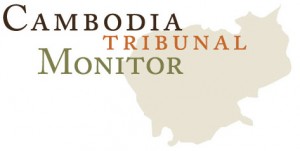Civil Party Was First Raped, Then Forced To Marry
Former head of S-21 photography unit Noem Oem, alias Nhim Kim Sreang, concluded his testimony today. Under questioning of the Co-Prosecution, he gave evidence as to the number of photographs taken at S-21 as well as the procedure. Civil Party Mom Vun then took her stance and told her court how she was first raped by five men and then forced to marry a man she did not like. She also recounted how she attended a meeting during which Nuon Chea spoke, at which she sang a revolutionary song.
Nhem En
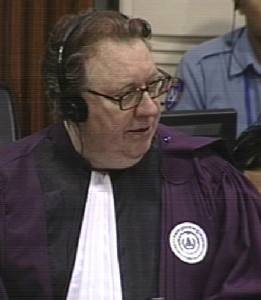
International Senior Assistant Prosecutor Dale Lysak
National Civil Party Lead Co-Lawyer Pich Ang was absent. The floor was granted to the Co-Prosecution to continue their questioning of witness Noem Oem, alias Nhim Kim Sreang. Mr. Lysak asked whether Nhem En worked at S-21 before he was trained to work for the witness. Mr. Kim Sreang replied that he did not know Nhem En before he started working for him. Mr. Lysak quoted his statement, in which he had said that Nhem En worked in a children’s unit with Duch. He replied that he knew this from his work. He could not recall the other children’s names. When they fled, they fled to the mountains. Mr. Lysak asked why he forgot all other children except Nhem En.[1] He answered that this was because they were there for a short period of time. He only heard of Nhem En’s name was when he spoke on Radio Free Asia. This jogged his memory, he said. There were also elderly people at S-21. One was over 70 years old.
Mr. Lysak presented a range of photographs to the witness.[2] When negatives were damaged, he would inform Duch, who in turn would then retake the photograph by going to Prey Sar. Mr. Lysak asked how he could identify the people whose photographs were destroyed. Mr. Kim Sreang replied that he knew it from taking the photographs. Suos Thy would inform him whose negatives were damaged. He rode a bicycle to Prey Sar. It took him almost an hour to go there. He had a travel pass, but there were not many checkpoints on the way. He would contact Huy Sre there to let him know what to do.
Number of Photographs
There were rank-and-file soldiers who were at Prey Sar. He had known them in the military before. “This is how I knew that they were minor people”. They sometimes took photographs outside.
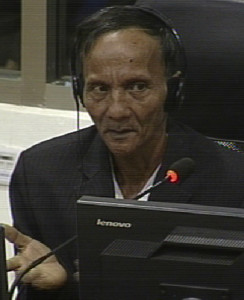
Witness Noem Oem
Mr. Lysak the photograph of Yim Khan alias Khuon.[3] He explained that there were cases in which people were sent from Prey Sar to S-21 after “investigations had been done”. He confirmed that they were photographed before being taken into the compound. Mr. Lysak asked whether he would be able to tell the court how many photographs had been taken at S-21.[4] Mr. Kim Sreang answered that they had taken between 4,000 and 5,000 photographs. He collected the films from photography-shops when Phnom Penh fell and kept them in his house. They never made a report on total numbers of prisoners, since it was Duch who was responsible for that. Mr. Lysak said that in trial alone 6,170 photographs were available, “and these are only the ones that survived”. Nuon Chea Defense Counsel Victor Koppe objected to the use of this number and said it was without basis. Mr. Lysak gave references for this number (for example David Chandler: Voices from S-21 [5]), and repeated his question whether Mr. Oem had only given a rough estimate. He said that this may be the case, and that other photographers had also taken photographs. He said that Sry, a member of the Party, was responsible for taking photographs of the senior people. Mr. Oem confirmed that he had not taken record of the number of photos he had taken.
Presiding judge Ya Sokhan informed the Deputy Co-Prosecutor that he had run out of time. The floor was briefly given to the Civil Party Lead Co-Lawyers. International Civil Party Lead Co-Lawyer Marie Guiraud inquired about the instance of rape. He recounted that the victim came from France. She was sick and was raped when she came to be treated. Other people witnessed the rape. He had not heard about any other similar instance since then. With this, Ms. Guiraud concluded her line of questioning.
Follow-up Questions by the Bench
The floor was given to Judge Jean-Marc Lavergne who inquired about the incident that led the witness’s ten-year-imprisonment. He changed his name from Noem Oem to Kim Sreang at the time. A family had an argument – the husband came home drunk and was angry at the wife who had not prepared dinner for him – and the witness said that the wife’s mother sought his assistance. He felt pity, but the husband became angry. Mr. Oem said that he “accidentally committed that crime” and was subsequently convicted of unintentionally killing someone.
Judge Lavergne then asked what happened to his instructors. He answered that after he had collected the left-overs at the photography shops, he sought Ta Nath’s help to find photographers to help translating the instructions. He gave them a bag of rice, but he did not know what happened to the photographer later on. He “practiced hard” to learn how to take photographs and to develop films. Three of them were sent to S-21 from Division 703 and brought the equipment with them to S-21. There was no proper monthly tally for used film rolls. He said that the figure may be between 4,000 and 5,000. They sometimes took photos two or three days in a row, and sometimes they only took them once a week. When there were not many prisoners who arrived, only his subordinates would take pictures and he stayed back to mix chemicals. He would help them when a bigger group arrived. He would take photographs at least monthly, and sometimes four or five times per month. When there was a wedding ceremony of a cadre, they would also be assigned to take photographs.
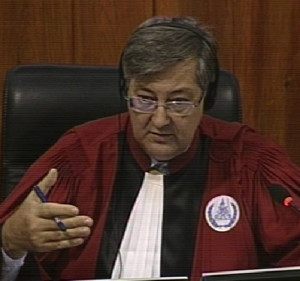
Judge Jean-Marc Lavergne
Other people filmed Vietnamese people being walked into the city.
Last Days at S-21
After the break, the witness told the court that one of his brothers was a messenger and a guard at the prison. He was later removed and sent to a vegetable growing unit. After this, he was assigned to herd cows at Prey Sar. His brother was not photographed. He fled together with the witness to Pursat and Battambang. The witness was told that his brother was shot later on and died. Messengers and interrogators were all removed later on. He came to S-21 from Division 703 through Ryt, who had asked him to escape from the hospital. Ta Nath assigned him to work as a photographer along with Nith and Song. A member of the photography unit escaped to Thailand with Mr. Oem’s gun and belongings. “I started to be very very terrified, because my brother was removed”. He was not involved in taking photos of people who were buried and then dug up to be photographed. He did not know whether the dead body of a person who was dug out was the body of Ta Nath, “because the body became swollen”. He developed the negatives of these photographs.
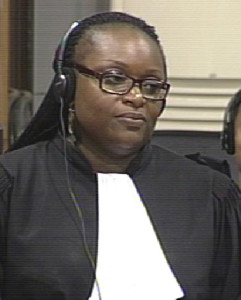
Khieu Samphan Defense Counsel Anta Guissé
He was called to take photographs in the morning after the prisoners had arrived in the evening. He could not recall when the last photographs were taken at S-21. Some of the photographs had not yet been developed.
The floor was granted to the Khieu Samphan Defense Team. Anta Guissé asked about the equipment. He recalled that he did not take any equipment with him when he fled. All the cameras and films remained stored in the room. The photographs at dams and dykes were not taken by his unit at S-21. He took such photographs when working at Division 703 to publish these in the magazines. Ms. Guissé wanted to know whether Nhem En went to six zones in the country while he was on assignment at S-21. He replied that it was difficult for him to comment on this, because the witness’s team was not allowed to move freely at S-21. As her last question, Ms. Guissé wanted to know whether he remembered the name of the historian who interviewed him a few months ago. He replied that it was a foreign woman. He did not know whether she was French or any other nationality. “Her name was something like An An”.
New Civil Party: Mom Vun
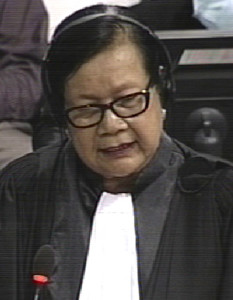
Civil Party Lawyer Chet Vanly
Civil Party Mom Vun (2-TCCP-283), 67, was born in Siem Reap Province. Ms. Chet Vanly was the first lawyer to put questions to the Civil Party. She lived in Siem Reap Province before 1975. She was married at the time. Her husband Tan Him was around 33 years old at the time and she was 28. Ms. Vanly said that her birth certificate said that she was born on 19 April 1942, which did not match her age of 67 that she had indicated. She replied that she was born in the year of the tiger. Someone had calculated that she was born in 1948.[6] Thus, she alleged that her birth year was incorrect.
She was assigned to harvest rice in the cooperatives when her child was young. When her child died, she was assigned to build dykes. Her parents lived together with her. Her parents and siblings passed away. Her older siblings were accused of joining the enemy and taken away and killed. Three were accused to attempt to join the enemy and were sent for re-education from which they never returned. Her mother died of sickness “as a result of the disappearance of husband and children”. The Civil Party’s husband was sent for re-education by mid-1975, because he was a former Lon Nol soldier. “In fact he got drunk and said he was a former Lon Nol soldier”. Someone heard this and he was taken to re-education and never returned.
She was forced to re-marry after three or four months of her husband’s disappearance. She first refused, but was told that she had to marry.[7] “I did not dare to talk about my second marriage, because I was ashamed of it”. Ms. Vanly asked why she had not mentioned this second marriage in her Civil Party application. When she attended a TPO meeting, she heard other women speak openly about their forced marriages, which was why she dared to talk about it. She was afraid that her husband would return when she was asked to re-marry, which was why she refused at first. “They said I had no choice, I had to re-marry”. Her unit chief Sea told her to do so. “If he would be to return, there would be big trouble”, she said about the fear of her husband’s potential return. She was not told which man she was going to marry. “I did not know which man I was to marry […]. And I had to marry that man, because otherwise I would be killed. And for that reason, I had to force myself to marry”.
Rape
Two days before the marriage, at night time around 7 pm, a group of comrades called her to go to a rice storage. There were around five comrades. “When I arrived there, I was told that I would re-marry, and I was called to go up to the rice storage. […]. My hand was pulled up and they planned to mistreat me before the wedding day. There were five of them and they planned to rape me one by one. And I was raped. The last one told me to live after this. I could barely walk […] and I wept.”
They threatened her. “They had a gun pointed at my head. I was ordered to take off all my clothes so that they raped me. And they raped me one by one. They threatened that if I said anything I would be killed. I remained quiet about this until now.” She could not identify them, since it was dark. When they were near her, however, she said that “I could say that they were around 26 to 27 years old”. She married again after this. “For the sake of my children I had to marry again, despite my tear”. She did not dare to say anything after the end of the regime even at the TPO meetings, because she was ashamed of this. “I want to say it now, because I want to tell everyone, to tell the world, how I was mistreated at the time”.
Forced Marriage
Moving to her marriage, Ms. Vanly asked whether she had the chance to tell her mother about her marriage. She replied that she did not inform any relatives about her wedding. “It was not a proper marriage according to the tradition of law.” It was held at the worksite. “For the man, he did not like me.” He disliked her, because she had already eight children at the time, and she disliked him as well. “But for the sake of my children, I had to marry that man.” Sea did not give her any reason why she had to marry. “We had to follow instructions”. Both sides, man and woman, would die if they refused. They accepted to get married “because we were afraid to be killed.”
At this point, the President adjourned the hearing for a break.
Pregnancy
She was informed about her marriage two days before the wedding day, which took place in 1975. The ceremony was held at Bay Phlouk Worksite. There were 60 couples at her worksite.[8] At another worksite, 40 couples got wed. “I was not happy at all. I was afraid and I was very worried that my husband would return and I did not like the man that I was supposed to marry”. She wore her work clothes. There were no chairs at the ceremony. She was matched with her husband, so they held hands before the next couple was called. No parents from any couple were present at the ceremony. They were told that they had to “produce children for Angkar”. Each couple was called to make commitment. In their commitment, she said that she was “committed to producing more children for Angkar”. Nobody could refuse being married.
When going to bed at night, they did not know yet that they were being monitored by militiamen. They agreed to “go with each other” first, and that they could go separately after. They were heard by militiamen and “they threatened us to sleep with one another. We were ordered to take off our clothes so that we could consummate the marriage. The militiamen had a torch to shed light on us and guns. We had no choice but to take off our clothes […]. They threatened us again and they used the torch on us, and they got hold of his penis and to insert it into mine. It was so disgusting. We had no choice. Those militiamen were so young. After we had sex they said “let’s move to the next couple”. She said she would never forget the events. “That was not the only night we were monitored. It happened again the night after. When they came, we saw sleeping and hugging one another, so they said we got along so well”. After they eavesdropped and heard that they were sleeping with one another, they stopped monitoring them. She became pregnant, after which they separated her husband from her. He was allowed to visit her once every two months.
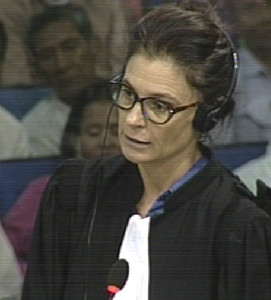
International Civil Party Lead Co-Lawyer Marie Guiraud
Her second husband requested divorce from her in 1984. She had four children during the Khmer Rouge regime with her second husband. She had two pairs of twins, one in 1976 and the other in 1977. One of them passed away. She had 14 children in total. Two of her children died during the Khmer Rouge regime. They died due to a lack of food and medicine.
She was instructed to attend an assembly in 1976.[9] Comrade Sea sent her there by foot. “We started from 4 o’clock in the morning and we arrived in the area of Phnom Kulen by 4 o’clock in the afternoon”. A performing arts group arrived the next day. She learned the song after hearing if from the group. She sang it while working. Thus, she was invited to sing at the assembly meeting. She did not see Samdech Euv the next day, but heard the announcement that they would receive Nuon Chea, Khieu Samphan, and Ieng Sary. She saw the three of them, among other cadres, on the stage. Nuon Chea made a speech on that day directed at the parents and youths, “to strive to produce more product in order to sustain the economic situation”. She was asked to go on stage when Nuon Chea finished and she sang a Revolutionary Song. The main message of the assembly was for everyone to “produce more” to assist the army. Asked about the song, she offered to the song: The Red Sun Song. She went back to the worksite by hiding on a horse cart. Someone had told her that the performers were taken away on a vehicle. She did not know what happened to them, because she never met them again.
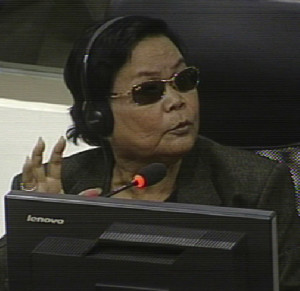
Civil Party Mom Vun
As follow-up questions, International Civil Party Lead Co-Lawyer Marie Guiraud asked the Civil Party to explain the living and working conditions were for pregnant women under Democratic Kampuchea. She remained working during her pregnancy and had to grind the rice after her pregnancy, which was considered “light work”. They produced large amounts of rice, she said, but gave them only porridge. They cooked the soup mixed with leech. After she delivered the baby, she only spent around one and a half months with the baby. She did not have breast-milk to feed her child. She and her baby became sick, but she could not rest. With this, the Civil Party lawyers concluded their line of questioning.
The floor was granted to the Co-Prosecution. Senior Assistant Prosecutor Vincent de Wilde asked about the assembly. Ms. Vun recounted that it took place in 1976. She was already married at the time. Those who attended the mass meeting also returned to their respective homes and worksites. She did not meet the cadres personally and only saw them on the stage when their names were announced. Only Nuon Chea spoke, and not Khieu Samphan or Ieng Sary spoke. The morning lasted until 2 pm before taking a break. This was the point where she returned to her home. Nuon Chea spoke about abiding by the rules during his speech. He had said that “the enemies of the revolution were the yuon”.
The person was not the commune chief, but people addressed him like that, because he “possessed so many cows”.
During her first marriage, monks were present and the ajar blessed them. There were many guests and parents from both sides gave their blessings. She was 16 years old at the time.
She did not know why she was separated from her husband. She did not dare to question them. Their children were not allowed to come back home but were ordered to stay at the mobile unit. She was told that her husband was sent to a training session, but he never returned. The unit chief told her so. The person who was in charge of the worksite assigned her with her husband.
He was attached to the district and received instructions from the district for the implementation of “that instruction”. They were threatened and could therefore not refuse to get married. “The women disliked the arrangement, but they could not refuse, so they had to get married”. Rom was known by both also known by the name of Thorn.[10]
At this point, the President adjourned the hearing for a break.
Rape
At the beginning of the last session, Mr. de Wilde asked whether she made a connection between her rape and her forced marriage. She explained that her marriage was arranged after her rapist told her that people who already had had sex were forced to marry. “I felt so painful, I wanted to commit suicide”.
Mr. de Wilde read an excerpt of her TPO interview, in which it was written that her marriage took place in late 1976.[11] She said that this was wrong, because her marriage took place in late 1975.
Comrade Phol “refused to love the man, and then it happened to her, and then I felt afraid”.[12] This was why the witness accepted the arrangement. Comrade Phol was killed before Ms. Vun marriage. “I tried to obey them in order to survive”.
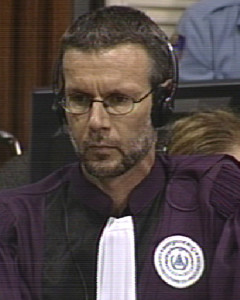
Senior Assistant Prosecutor Vincent de Wilde
She agreed to the intercourse, because she knew she “would be in trouble” if she did not. After she became pregnant, she and her husband were separated from each other. She heard that children were “the children of Angkar” and she was told to “produce many children so that Angkar would have many children”.
Before her marriage, she was raped. She did not know whether it happened to other women. Mr. de Wilde read an excerpt of a statement, in which another rape was mentioned.[13] When he tried to refresh her memory, the Defense Teams objected. The objection as overruled. When Mr. de Wilde read this statement, she remembered the incident. Comrade Dyn was working in the cooking section. When she was found out, she was taken to Kampong Kdei. Dyn was an ethnic Vietnamese. Ms. Vun’s team was working at Kampong Kdei Dam, when they heard the woman screamed. “After the woman was raped, her back was cut open and her gall bladder was put into the rice wine to be drunk by the Khmer Rouge cadre. We heard the Khmer Rouge say so, but my team did not dare to look. We only focused on carrying earth. At that time, every ethnic Vietnamese was taken away to be killed. Only the ethnic Chinese were spared”. There were no Cham.
Nuon Chea Defense Counsel asked how many husbands she had had. She answered that she only had two husbands. Her first husband was a palm tree climber and not a government official. All her children with her previous husband were born prior to the Democratic Kampuchea regime. She did not know the former occupation of her second husband. One of the twins passed away. As for his parents and his four siblings, they “had all been killed”. His native village was in Kralang, but he did not return.
For the wedding of the sixty couples there were flowers in two vases and there was a chicken in order to pray to the ancestors. She presumed that this was its task. The cadres ate the chicken “while we still ate the same soup”. The cadre Rom was a man. Sea, Sang and Rom were all male. He was part of the district branch at the time. When the district chief assigned him to go to the wedding, they would organize the wedding. Mr. Sovanna said that she had said that Comrade Sea was in charge of the cooperative, while she had said in her statement that Rom, alias Thorn, was in charge of the district.[14] She explained that the assignment “came down” from Rom to Sea. When Mr. Sovanna probed on the issue, the Co-Prosecution objected based on repetitiveness. The objection was sustained. She attended the assembly in 1976.
She knew that all sixty couples were forced, “because they all wept”. They stopped weeping only when it was their turn to make the vow. “None of them volunteered to marry. How could it happen that sixty could be married at once?” Moreover, “there was no permission at all from our parents. And that’s how we all wept”. Two couples got married, “and instead they died”. As for her husband, she said that her husband had “boasted” that he was a former teacher, and when he got drunk, he “boasted that he was a former Lon Nol soldier”.[15] She said that in reality he climbed palm trees. When Mr. Sovanna pressed on the issue, she said that the person who wrote her complaint may simply have noted down that he was a teacher or soldier, even if she had said that he said this when he was drunk.
Mr. Sovanna asked why she had said in 2010 that she mentioned that her first husband and her got divorced, while she now said that he was taken away and killed.[16] Mr. de Wilde said that there was an “important difference”: the French version mentioned “separation”. Nuon Chea Defense Counsel said that English version stated “divorced”. Mr. Sovanna read out a document, in which it was stated that they got divorced in 1972. She recounted that her husband had an affair and they got divorced in 1972. However, they reconciled a fortnight later and continued to live together until 1975. Mr. Sovanna read another paragraph of the statement, in which she had said that she had to raise her eight children “all by herself”. She said that she had to take care of the children by herself. However, when they reconciled they lived together again.
The hearing will continue on Monday, September 19, 2016, with Civil Party 2-TCCP-251 on the regulation of marriage via audiovisual conference. The testimony of today’s Civil Party will then continue.
[1] E3/7639.
[2] E3/9837, at photo 791; P01223809; E3/8639.5110; .2484 ; .1975 ; .3668 ; .4034.
[3] E3/8639.3998; E3/10248, at 01016745 (KH).
[4] E3/8639.4082; .3989; .4084.
[5] E3/1684,a t 00192706 (EN), 00191861 (KH), 00357291 (FR).
[6] The Year of the Tiger closest to this date is 1950.
[7] E3/6307.
[8] E3/7234, at 00103335 (KH), 01077096 (EN), 01030451 (FR).
[9] E3/7234, at 0100335 (KH), 01077096 (EN), 01030451 (FR).
[10] E3/7234, at 01003336 (KH), 01077096 (EN), 01030451-52 (FR).
[11] E3/7234, at 01030451 (FR), 01003335 (KH), 01077096 (EN).
[12] E3/7235, at 01112072 (FR), 01074565 (EN), 01003343 (KH).
[13] E3/7235, at 01003344 (KH), 01074566 (EN), 01112074 (FR).
[14] At 01003336 (KH), 01077096 (EN), 01030452 (FR).
[15] E3/7234, at 01003333 (KH), 01077095 (EN), 01030450 (FR); At 01137822 (FR), 01168543 (EN).
[16] E3/7234, at 01003334 (KH), 01077095 (EN), 01030451 (FR).
